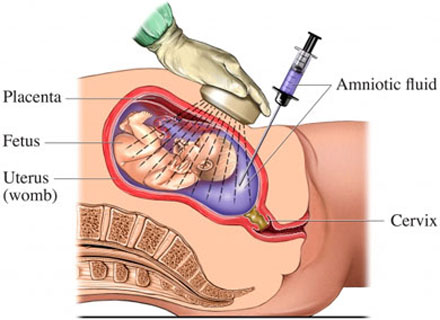Amniocentesis procedure / test and Risks

What is Amniocentesis procedure / test
Amniocentesis is a diagnostic procedure to withdraw a sample of AMNIOTIC FLUID from the UTERUS of a pregnant woman to obtain information about the health status of the FETUS. Obstetricians use amniocentesis, typically performed during the second trimester of PREGNANCY, to help diagnose GENETIC DISORDERS and health conditions of the developing fetus such as DOWN SYNDROME or SPINA BIFIDA and other NEURAL TUBE DEFECTS. Amniotic fluid contains cells from the fetus that can provide a KARYOTYPE (representation of CHROMOSOME pairings) and other genetic information about the fetus. The amniotic fluid may also provide information about the woman’s health, such as whether any INFECTION is present, and help doctors determine whether the fetus’s lungs are mature.
To perform amniocentesis, the obstetrician first numbs a small area on the surface of the woman’s abdomen, either with a topical anesthetic spray or an injection of local anesthetic. The obstetrician then inserts a long needle through the woman’s abdominal wall into the amniotic sac and withdraws about 20 milliliters (less than an ounce) of amniotic fluid for laboratory analysis. ULTRASOUND helps determine the position of the fetus and the ideal insertion and placement of the needle so as to avoid injury to the fetus. Because the laboratory must first cultivate cells from the amniotic fluid, GENETIC TESTING results take two to three weeks.
Amniocentesis Risks
Risks of amniocentesis include bleeding, infection, injury to the fetus, and spontaneous ABORTION (loss of the pregnancy). Some women feel temporary discomfort during the procedure, and many women find the requisite full BLADDER (necessary for the ultrasound) causes pressure and other discomforts. Some women experience mild cramping and slight bleeding for a day or two after the amniocentesis.
See also ALPHA FETOPROTEIN (AFP); ANESTHESIA; CHORIONIC VILLI SAMPLING (CVS); CHROMOSOMAL DISORDERS; CONGENITAL ANOMALY; PRENATAL CARE.